Another digest of daily posts during Hull2017 on Facebook, about the pictures added daily on the intro page at Hull Photos. Comments and corrections to the captions and texts about the pictures are always welcome here or on Facebook.
Hull Photos
25th November
A second slightly closer view of the boats and buildings on the wharf on Tower St. The word HULL on the stern of the smaller boat is more clearly visible. This was a part of the premises of Alan R Worfolk, Ship Repairers & Marine Engineers.
The buildings in the background are roughly where the ugly bulk of the Premier Inn now stands
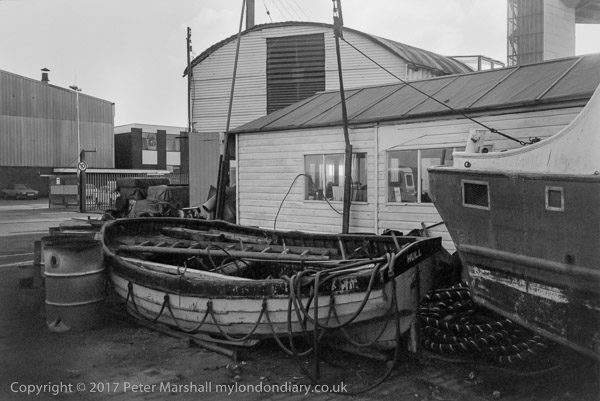
85-10l-13: Boats in yard and Tidal Barrier, Tower St, 1985 – River Hull
26th November
Alan R Worfolk, Ship Repairers & Marine Engineers offered ‘Engine Workshop Overhauls up to 30 Tonnes’ at their wharf on Tower St. Although the tides are sometimes high, the boat on the roof of the nearer structure is probably not there in case of or as a result of flooding.
This area of Hull, Garrison Side, to the east of the mouth of the Hull was as the name states, the site of a large fort protecting the city from attack from the River Humber. The earliest defence of the River Hull was simply a chain which could be taken across the mouth of the River Hull to close it to ships, but Henry VIII decided it needed a proper castle too as England expected a Dutch invasion. The castle was built into a much more extensive Citadel in the 1680s, and this remained a military fort until around 1848, and was demolished in 1864. The Dutch invasion only really arrived with the opening of Hull Marina in 1983.
The point on which The Deep now stands is Sammy’s Point, named after Martin Samuelson, the son of a Liverpool merchant born at Hamburg in 1825 who was an apprentice at Caird and Co, engineers and ship builders in Greenock who made Clyde Paddlers. In 1849 he came to Hull working as Martin Samuelson and Co and making steel boilers, hydraulic presses for seed crushing and building ships. They had premises in Neptune St, but built a total of 97 ships in 10 years on what is now ‘Sammy’s Point’, including some early steel vessels before selling the works in 1864 to the Humber Ironworks and Shipbuilding Company who soon became the largest shipbuilder on the Humber but were bought up by Cook, Welton & Gemmell Ltd in 1866 – though this company seems only to have begun making ships around 1880. They moved to Beverley in 1901, closing in 1963, and the Beverley yard, taken on by others, finally closed in 1977. Samuelson continued to work in Hull, as a Consulting Engineer and Marine Surveyor and Valuer and became an Engineer to the Humber Conservancy Commissioners, working up until the day of his death at the age of 78.
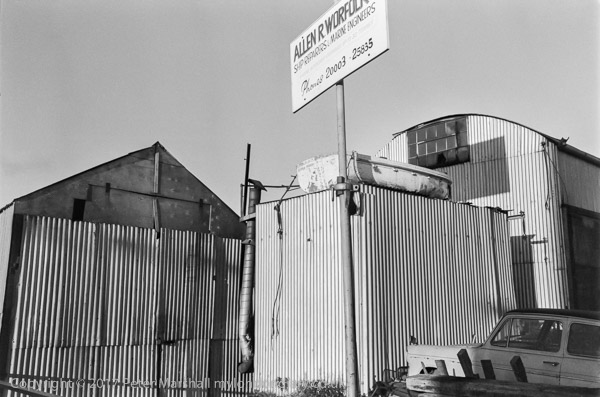
85-10l-14: Alan R Worfolk, Ship Repairers & Marine Engineers, Tower St, 1985 – River Hull
27th November
A new slipway was built at on the River Hull at Sammy’s Point in 1962 to enable light floats to be pulled up to a buoy shed being built by the Humber Conservancy Board.
Trinity House had been made responsible for safe navigation in the Humber estuary around 1512, and their Buoy Shed is a Grade II listed building a few hundred yards up-river. The responsibility for buoys etc passed to the Humber Conservancy Board in 1907 and following the nationalisation of the British Transport Docks Board in 1981 is now carried out by ABP Humber Estuary Services.
The negative for this image was on the end of a roll and suffered some fogging by light at the right hand edge, and has been digitally restored though some damage remains

85-10l-16: Buoys, Sammy’s Point, 1985 – River Hull
28th November
Several tankers are moored by John H Whitaker (Tankers) Ltd’s wharf in the foreground on the Garrison Side (east bank) of the river, including the Humber Renown and Newdale H, while on the other side the moored vessels include the Maureen Anne W along with a number of barges and others.
At the centre of the opposite bank is Bishop Lane Staithe and Ellerman’s House. You can just see the top of the Guildhall Tower above the closer buildings and on the rooftop of one of these just to the right stand a small group of men, looking at and perhaps plotting the future of the area.
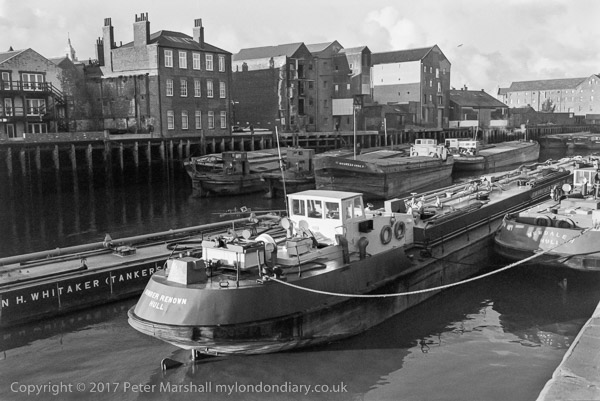
85-10l-21: The Old Harbour, River Hull, 1985 – River Hull
29th November
Taken from beside the River Hull, the aggregates wharf had its street entrance on Tower St, roughly opposite where the Holiday Inn now stands. The sand and gravel was landed at the wharf, some coming by barges from around the Trent. Latterly I think it may have been owned by Tarmac Quarry Products Ltd.
In the background you can see the recently completed Myton Bridge, or rather the approach to it, Garrison Way, and the spiral pedestrian access to it from Tower St. The large sheds beyond are in the area now occupied by The Deep.
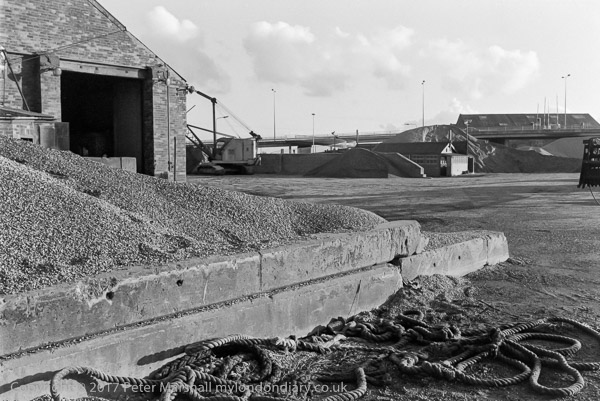
85-10l-23: Tower St Sand and gravel wharf, Garrison Side, 1985 – River Hull
30th November
Taken a few feet from the previous image it shows the same pile of gravel and brick building, but also the fence between the wharf and the property immediately to its north on the river bank.
The painted writing on the wooden board attached to the property is difficult to make out, though the words TOWER STREET WHARF are reasonably clear and the name across the bottom ends in HAM. The name at the extreme left is only part visible, ‘….pso. ….tics’ but is revealed in the next image.
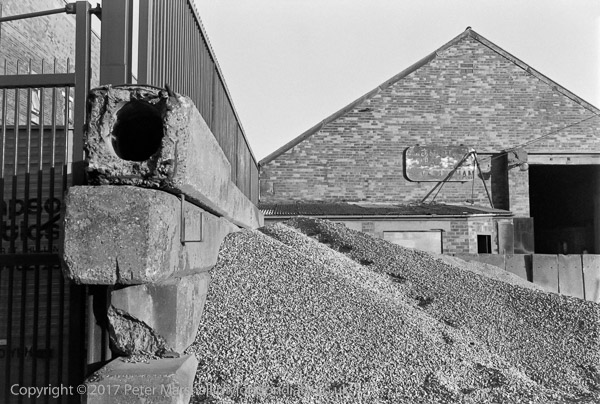
85-10l-24: Tower St Sand and gravel wharf, Garrison Side, 1985 – River Hull
1st December
My final view of the brick building on the sand and gravel wharf was from a few feet further on and shows a more frontal view. The company name on the board on this building on Tower Street Wharf is no clearer, but the premises at the left of the image – immediately to the north on the riverside are shown to be those of ‘thompson plastics – vacuum moulding and fabrication’.
Established in 1977 as Thompson Plastics (Hessle) Ltd, in 1989 it became Thompson Plastics (Hull) Limited was the subject of a management buyout in 2008, when it employed 560 people at its head office in Hessle but together with went into administration the following year, though parts of the Thompson Plastic Group remained viable. One of its main businesses was producing plastic mouldings for use in caravans.
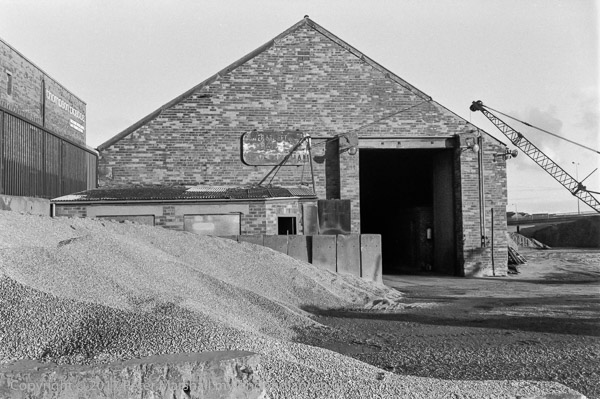
85-10l-26: Tower St Sand and gravel wharf, Garrison Side, 1985 – River Hull
You can see the new pictures added each day at Hull Photos, and I post them with the short comments above on Facebook.
Comments and corrections to captions are welcome here or on Facebook.
______________________________________________________
There are no adverts on this site and it receives no sponsorship, and I like to keep it that way. But it does take a considerable amount of my time and thought, and if you enjoy reading it, a small donation – perhaps the cost of a beer – would be appreciated.
My London Diary : Buildings of London : River Lea/Lee Valley : London’s Industrial Heritage
All photographs on this and my other sites, unless otherwise stated, are taken by and copyright of Peter Marshall, and are available for reproduction or can be bought as prints.